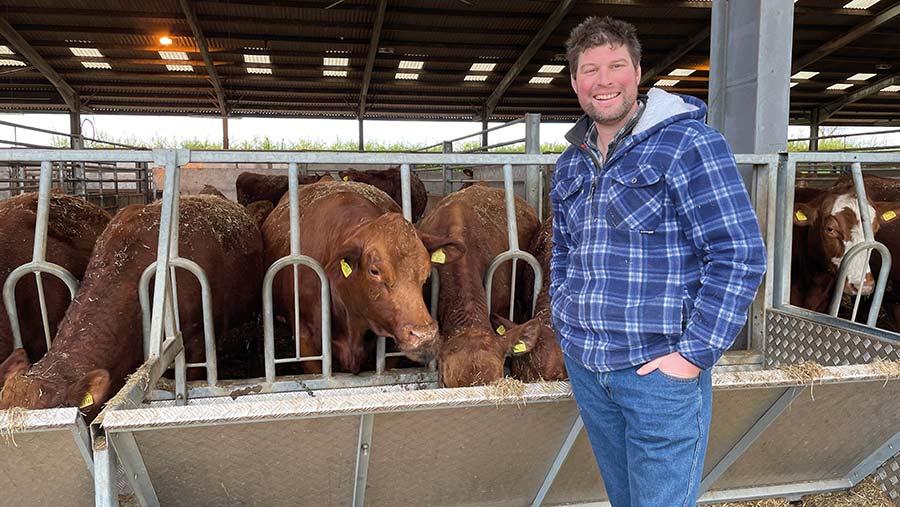How carbon auditing is improving beef performance
 Beef producer Tim Phipps © Morrisons
Beef producer Tim Phipps © Morrisons Beef producer Tim Phipps is one of a number of farmers lowering his carbon footprint thanks to data collected by ongoing greenhouse gas audits.
Data insight experts Map of Ag says its platform addresses a weakness of some existing carbon calculators.
It says it provides insights that help farmers understand how to improve in metrics that are easily understandable.
See also: 4 popular carbon calculators for farms compared
Map of Ag has built connections with key data sources, including some the main carbon calculators don’t currently use, such as British Cattle Movement Service (BCMS), explains Hugh Martineau, Map of Ag’s head of sustainability.
This increases accuracy of greenhouse gas emissions when used in conjunction with other data sources, such as farm management software and kill data from abattoirs, as well as from Mr Phipps.
The carbon audit is presented in a similar way to other calculators, comparing emission intensity, with breakdowns by each greenhouse gas and benchmarking against other farms.
Where Map of Ag adds value is by automatically generating key performance indicators based on the data collected.
“Tim’s efficient system already produces low emissions-intensity beef, so high-resolution data is important to help identify where additional emissions reductions can be achieved,” says Mr Martineau.
The analysis is providing valuable, actionable information in three areas for the 340ha mixed family farm, which runs 150 Stabiliser cows.
These will improve both business performance and reduce overall emissions by about 15% on the Morrisons’ Blueprint demonstration farm.
Attention to detail straight after calving
Farm slaughter data highlights the disparity between finishing efficiency for bull calves and heifers.
Mr Phipps, who farms in Northamptonshire, sells bulls at 12-14 months for beef to supermarket chain Morrisons.
Heifers unsuitable for breeding are grazed for a second year prior to being sold at 23-24 months.
Target slaughter weights for bull calves are 375-410kg deadweight, but a few underperformers bring down the average.
In contrast, there are lower and more variable deadweight and age at slaughter figures with the finished heifers.
“Intrinsically these are the least efficient in our herd. Anything that hasn’t reached 400kg at 400 days isn’t selected for breeding,” Mr Phipps says.
“Being able to see the outliers in both situations is really useful on understanding what to do better.”
For example, there is a correlation between animals that have not had adequate colostrum transfer at birth, he explains.
“That means they have been poorly early in life, upsetting their rumen, and means you’re fighting against poor rumen performance all their life.”
Greater attention on monitoring calves to make sure they feed within the first few hours of life should help mitigate this, he says.
“And if there is anything wrong, we will give them a boost of colostrum.”
Use sexed semen to improve efficiency
The project has helped identify 32% lower greenhouse gas emissions in finished bulls compared with finished heifers.
With the help of Morrisons’ net-zero project partners Raft Solutions, Mr Phipps is hoping to trial sexed semen in his beef cows to target maternal genetics in the animals bred as replacements.
“We always breed our replacements with the best genetics in the hope we can retain those animals as our future replacements,” Mr Phipps says.
“This means we can also target terminal beef traits in animals less suitable for breeding replacements.”
This more precise approach should produce more, low emissions beef.
Reducing N and protein requirements
Another strand to lowering emissions is by reducing protein requirements and the use of synthetic fertiliser.
Mr Phipps is working with his beef nutritionist and Raft Solutions to reduce dietary protein requirements by monitoring rations and trialling the inclusion of synthetic amino acids (methionine).
This approach is used in pigs and poultry and should help reduce crude protein requirements in rations.
More legume-rich swards are being introduced into the arable rotation.
“By growing the legume-rich swards and cutting the forage at the right point, we’re hoping that should negate the need to import protein concentrates,” he explains.
The increased area of legume-rich swards should also decrease the amount of fertiliser required on the rest of the grazing platform, and in the following wheat crop.
